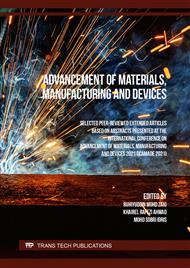[1]
Jaffe, H. (1958). Piezoelectric ceramics. Journal of the American Ceramic Society, 41(11), 494-498.
DOI: 10.1111/j.1151-2916.1958.tb12903.x
Google Scholar
[2]
Muhsen, K. N. D. K., Osman, R. A. M., & Idris, M. S. (2020). The effects of Ca, Zr and Sn substitutions into a ternary system of BaTiO3–BaSnO3–BaZrO3 towards its dielectric and piezoelectric properties: a review. Journal of Materials Science: Materials in Electronics, 1-13.
DOI: 10.1007/s10854-020-03756-2
Google Scholar
[3]
Sharma, S., Shamim, K., Ranjan, A., Rai, R., Kumari, P., & Sinha, S. (2015). Impedance and modulus spectroscopy characterization of lead-free barium titanate ferroelectric ceramics. Ceramics International, 41(6), 7713-7722.
DOI: 10.1016/j.ceramint.2015.02.102
Google Scholar
[4]
Muhsen, K. N. D. K., Osman, R. A. M., Idris, M. S., Nadzri, N. I. M., & Jumali, M. H. H. (2021). Effect of sintering temperature on (Ba0.85Ca0.15)(SnxZr0.1-xTi0.9)O3 for piezoelectric energy harvesting applications. Ceramics International, 47(9), 13107-13117.
DOI: 10.1016/j.ceramint.2021.01.175
Google Scholar
[5]
Luo, B., Wang, X., Tian, E., Song, H., Zhao, Q., Cai, Z., Feng, W. & Li, L. (2018). Giant permittivity and low dielectric loss of Fe doped BaTiO3 ceramics: experimental and first-principles calculations. Journal of the European Ceramic Society, 38(4), 1562-1568.
DOI: 10.1016/j.jeurceramsoc.2017.10.014
Google Scholar
[6]
Rani, A., Kolte, J., Vadla, S. S., & Gopalan, P. (2016). Structural, electrical, magnetic and magnetoelectric properties of Fe doped BaTiO3 ceramics. Ceramics International, 42(7), 8010-8016.
DOI: 10.1016/j.ceramint.2016.01.205
Google Scholar
[7]
Gouitaa, N., Lamcharfi, T., Bouayad, M., Abdi, F., & Hadi, N. (2018). Impedance, modulus and conductivity studies of Fe3+ doped BaTiO3 ceramics prepared by solid state method. Journal of Materials Science: Materials in Electronics, 29(8), 6797-6804.
DOI: 10.1007/s10854-018-8666-3
Google Scholar
[8]
Wei, X. K., Su, Y. T., Sui, Y., Zhang, Q. H., Yao, Y., Jin, C. Q., & Yu, R. C. (2011). Structure, electrical and magnetic property investigations on dense Fe-doped hexagonal BaTiO3. Journal of Applied Physics, 110(11), 114112.
DOI: 10.1063/1.3658813
Google Scholar
[9]
Keith, G. M., Rampling, M. J., Sarma, K., Alford, N. M., & Sinclair, D. C. (2004). Synthesis and characterisation of doped 6H-BaTiO3 ceramics. Journal of the European Ceramic Society, 24(6), 1721-1724.
DOI: 10.1016/s0955-2219(03)00495-3
Google Scholar
[10]
Yusoff, N. H., Osman, R. A. M., Idris, M. S., Muhsen, K. N. D. K., & Nor, N. I. M. (2020, January). Dielectric and structural analysis of hexagonal and tetragonal phase BaTiO3. In AIP Conference Proceedings (Vol. 2203, No. 1, p.020038). AIP Publishing LLC.
DOI: 10.1063/1.5142130
Google Scholar
[11]
Voisin, C., Guillemet‐Fritsch, S., Dufour, P., Tenailleau, C., Han, H., & Nino, J. C. (2013). Influence of Oxygen Substoichiometry on the Dielectric Properties of BaTiO3‐δ Nanoceramics Obtained by Spark Plasma Sintering. International Journal of Applied Ceramic Technology, 10, E122-E133.
DOI: 10.1111/ijac.12058
Google Scholar
[12]
Hang, Q., Zhou, W., Zhu, X., Zhu, J., Liu, Z., & Al-Kassab, T. (2013). Structural, spectroscopic, and dielectric characterizations of Mn-doped 0.67BiFeO3-0.33BaTiO3 multiferroic ceramics. Journal of Advanced Ceramics, 2(3), 252-259.
DOI: 10.1007/s40145-013-0068-7
Google Scholar
[13]
Li, H. M., Ra, C., Zhang, G., Yoo, W. J., Lee, K. W., & Kim, J. D. (2009). Frequency and temperature dependence of the dielectric properties of a PCB substrate for advanced packaging applications. Journal of the Korean Physical Society, 54(3), 1096-1099.
DOI: 10.3938/jkps.54.1096
Google Scholar
[14]
Raies, I., Al Dulmani, S. A., Ben Farhat, L., Fadlallah, E. E., & Amami, M. (2020). Temperature-dependent magnetic and electrical properties of Cr-doped AlFeO3 ceramics. Journal of Asian Ceramic Societies, 8(4), 1095-1107.
DOI: 10.1080/21870764.2020.1819516
Google Scholar
[15]
Muhsen, K. N. D. K., Osman, R. A. M., & Idris, M. S. (2019). Giant anomalous dielectric behaviour of BaSnO3 at high temperature. Journal of Materials Science: Materials in Electronics, 30(8), 7514-7523.
DOI: 10.1007/s10854-019-01065-x
Google Scholar
[16]
Irvine, J. T., Sinclair, D. C., & West, A. R. (1990). Electroceramics: characterization by impedance spectroscopy. Advanced materials, 2(3), 132-138.
DOI: 10.1002/adma.19900020304
Google Scholar



